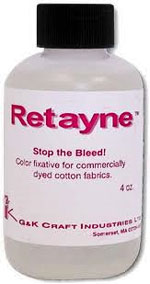This post contains affiliate links for which I receive compensation
Prewashing Quilt Fabric
by Rosimar
(San Antonio, TX)
Is it really necessary to prewash 100% cotton material?
Thank you very much,
Rosimar
Reply
In a word, no.Do I? Yes, always.
Because my whole stash is already washed, everything new that comes into it is too, unless it's for a project that I specifically need unwashed fabric for. (The technique for invisible machine applique comes to mind.)
What does prewashing really accomplish?
Pre-washing shrinks and cleans your fabrics. If you use a lot of different types of fabric in your quilts, it kind of 'equalizes them. You won't have one fabric that shrinks a lot and distorts the look of your finished quilt when it gets washed sometime out in the future.Working with clean fabric appeals to me, too. Some of the quilt stores I shop have the excess fabric on the floor. Now, don't get me wrong, I'm not complaining, I like an organized store, but having those extra goodies that there's just no room for on the shelves does make my heart sing. A bit of a treasure hunt. BUT, it is on the floor. It was transported on a cargo ship from Asia to get here, so it's probably been sprayed for bugs. So washing it just seems to me to be the thing to do.
Finally, washing removes any sizing. I'm happy to starch my fabric to give it the amount of body or stiffness that I want when I piece. I want to know what the fabric really feels like.
I used to think that pre-washing guaranteed that your fabric wouldn't bleed. For most fabrics this is probably true. But I've had a few that were pre-washed bleed into finished quilts. That hurt!
Now you might be thinking, 'Hey Julie! This quilt won't ever be washed. It's a wall quilt.'
I used to think that, but read my story about the Sad Little Penguin Quilt and you'll see that accidents do happen.
And if you'll use a technique that means you'll have to get the quilt wet...like removing the blue washout marker lines from marking machine quilting designs or blocking a quilt into a square shape...knowing that your fabric isn't going to bleed is a good insurance policy to have.
Save time by testing for bleeding fabric
Now, if those aren't reasons enough for pre-washing (and I understand that, it's work and time, and we've all only got so much time), then I do suggest you test for bleeding fabric.It's very simple to do, no fancy equipment, it won't take much time and it'll give you some piece of mind about washing your quilts in the future. Click here to learn about how to test for bleeding fabric.

The instructions on the bottle tell you to agitate the fabric in a hot water wash with Retayne for 20 minutes (my new washer doesn't let me do that). The instructions specifically state the water must be 140°ree;F, if its not that hot then add boiling water from the stove. They're serious about using hot water. After 20 minutes, then rinse with cold and dry.
From this point forward the fabric should always be washed in warm water with a cold rinse. Never use hot water.
If it was me and I had a bleeder like that, I substitute another fabric. Just not worth the aggravation down the road.
Rosimar, I hope this has helped to answer your question about pre-washing quilt fabric.
Piecefully,
Julie Baird
Editor














